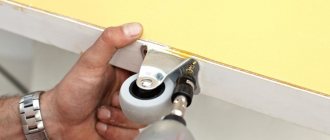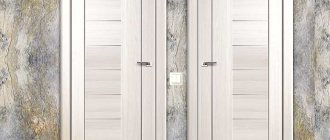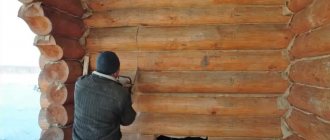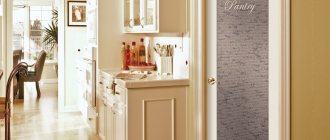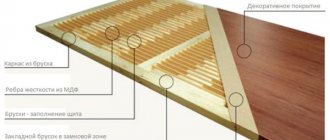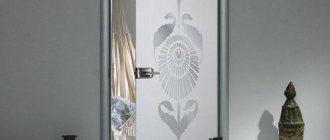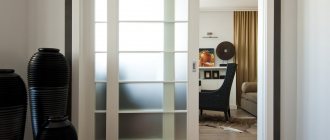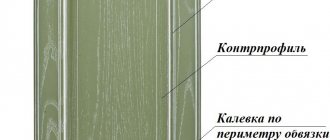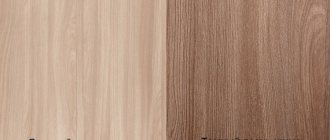Features of hidden doors, materials of manufacture
A secret door is a special design that is difficult to see in the surrounding environment. Usually behind such doors they hide niches or full-fledged rooms that you don’t want to show to strangers.
Today, there are many ways and recommendations on how to make a secret door and fit it harmoniously into the interior.
Manufacturing materials:
- Tree. A door made of this material may look like a cabinet compartment, in which case no one will guess what is behind it.
- PVC. Such a door is equipped with double-glazed windows, or it is covered with a plastic panel. It is quite difficult to disguise such a product.
- Glass. Tempered glass coated with impact-resistant film is durable and not subject to mechanical stress. The coating can be almost anything - acrylic, mirror film, varnish or even wallpaper. The variety of coating options and the smoothness of the surface make the door almost invisible.
- Metal. It is durable, but such a door is difficult to paint or process in any way, and therefore camouflage is quite problematic.
Wall decoration with an almost invisible door Source pinterest.ru
Opening mechanisms:
- Swing door. The opening principle is the same as that of a regular door, so it is easy to implement. Such a product is practically invisible against the background of the wall; the presence of a passage is revealed only by the handle or noticeable outlines.
- Roto door. Expensive and unusual way. The door rotates like a vertical turnstile - there is a central hinge, relative to which the door leaf rotates around its axis. You don't need a handle to open the door, you just need to push it lightly and it will turn. For greater tightness, the canvas can be equipped with a magnetic lock.
Secret door with a swing mechanism Source teremdoor.ru/
Pivoting invisible door Source linvisibile.ru
- Pendulum door. It is based on a rotating mechanism, so the doors open both towards and away from you. The mechanism is hidden in canopies located above and below the door leaf. Also, if necessary, closers are installed in canopies, which is quite convenient, because in this case the doors close automatically. This is an average cost option, however, there is a small drawback, the door will not provide soundproofing.
- Sliding door. The design assumes the presence of hidden hinges and a pencil case mounted directly into the wall. The door slides into the pencil case, due to this, great space savings are achieved, because there is no need to leave space to open the door in the traditional way. The door opens and closes silently, and the door itself does not allow sound to pass through. It is possible to install an electric mechanism to move the door.
Types of secret doors
Hidden doors are divided into several types - from simple to complex designs. It all depends on the design method. It can be made part of the wall, decorated with decorative details, or hidden behind a piece of furniture.
Secret door in the wall
Disguising a passage under a wall is one of the most popular, convenient, but not the easiest ways to design openings. This method is suitable for modern minimalist interiors, modern and high-tech styles. Masking is done by covering the canvas with wallpaper or painting it to match the walls of the room. Decorating the wall with tiles or plaster will also help to hide the passage.
Visually, you can hide the rectangle of the door by painting the walls with a geometric pattern. Among similar shapes (squares and rectangles), it will simply become invisible. When installing a secret passage disguised as a wall, you need to use a plinth instead of a threshold to connect the flat surface together.
Of particular importance for the design of an inconspicuous design are hidden, invisible fittings, handles, and locks. These elements can give away the location of the passage. Sliding structures without handles or other elements are considered convenient and invisible.
Secret door-wardrobe
An easy way to hide a secret door is to install a cabinet in its place. You can make a custom cabinet equipped with a door frame or nail shelves to the installed structure. This method was common in ancient times in castles equipped with many secret passages. Now, installing this type of hidden door panel will help save space by creating additional storage cabinetry. The imitation serves as a bookcase and wooden shelves where souvenirs are stored.
When installing hidden doors in cabinets, it is worth considering the weight of the structure. It should not be heavy, otherwise the canvas will not withstand the load. All items placed on shelves must be secured or waxed to prevent them from slipping.
Secret door with mirror
Even the most inexperienced layman can hide a doorway on his own by disguising it with a mirror. Typically, a homogeneous large mirror is used, the size of which corresponds to the size of the surface to be hidden. A decorative frame framing the reflective surface will help hide the box and replace the casing. The opening handle is located in this frame. The structure is fixed to the MDF overlay, to the canvas.
The decorative element at the passage site is a full-fledged high mirror. This method of decoration is convenient to choose for dressing rooms, bathrooms or corridors. Also, a reflective surface can visually expand the space.
Decorating with a painting
Hiding a door behind a picture is as easy as hiding a door behind a mirror. At the same time, you don’t have to worry that it might break. The image on the decorative canvas depends entirely on the taste and imagination of the owner, the style and direction of the interior. The choice is very wide - reproductions of classical paintings, contemporary art, just photo wallpaper or enlarged photographs. You can do the installation work yourself, without the help of assistants. This solution will give the interior a special zest.
Masking the opening with a curtain
Using a curtain to disguise an invisible door is simple. You need to fix the window cornice over the opening and hang the selected curtain. The cornice can be hidden inside the suspended ceiling structure.
Curtains that replicate window curtains will fit into the overall picture and will not attract unnecessary attention. The material is selected so that it matches other interior details, sofa upholstery, wallpaper, and other fabrics. It is worth covering the passages in the corner of the room with a curtain - this way they will be less noticeable. It is better to hide a safe or a room with jewelry under a secure door with a secret opening mechanism or lock. The curtain is suitable for decorating passages to pantries, niches, and other living rooms.
Examples in the interior
A secret door can become an important and appropriate part of almost any room. At the same time, you can disguise the door in the interior in several ways:
- Under the closet. A fairly simple method in which the door imitates a closet. Moreover, the shelves can be left either open or closed.
- Under the wardrobe. In this case, the canvas is designed like a cabinet door.
- Under the curtain. If the chosen style of room decoration involves the presence of curtains, then this method of hiding the door is quite simple. Curtains can serve as a decorative element under which a passage or niche will be hidden. Or, another option, hang a massive mirror or picture on the door, and hang a curtain on the side and secure it beautifully with a tieback.
- For painting. Typically this is a swing or rotary door, which does not require a door handle. The door covering can imitate wallpaper, brickwork or tiles, making the entrance almost indistinguishable among the wall decoration.
- Under the mirror. It looks like a floor-length mirror. When looking at such a structure, you don’t even think that there might be a passage or room behind it.
In the kitchen
In small kitchens, you want to unload as much as possible and leave the maximum amount of free space. A secret interior door will help to expand the space a little, even visually.
The door merges with the wall in the kitchen Source interior.ru/
In the bedroom
The bedroom often has exits to a dressing room or bathroom; such an entrance can be successfully played around and made unnoticeable. The door can be installed in the closet, or merged with the wall.
The door is only revealed by the handle Source sofiadoors.com
In the living room
In the living room you can use wallpaper with a pronounced ornament and pattern. In order not to interrupt the image, the door to the next room can be covered with the same texture.
Disguised door in the living room Source journal.homemania.ru
Even a simple plain door can become invisible if you distract attention from it with a bright accent on the adjacent wall.
In the hall
The front door may not match the style of the room, so it can be disguised to match the wall decoration.
Large houses often have stairs, the free space under which can be used for a hidden room. An unusual option is a secret door under the stairs.
Hidden storage systems under the stairs Source lestnitza.ru/
The storage room can be hidden behind a closet in the hallway.
DIY making
If there are only “invisible doors” on sale and you can’t just buy a real secret door, then you can always make one. These products do not have any complex designs. The whole process will not require much effort or cost.
In order for the result to be good, certain requirements must be adhered to. The door frame must be hidden or disguised - sometimes you can hide it by covering it with plasterboard. Loops should also be chosen as a hidden type. If it is a sliding system, then it should also be hidden.
Experts do not recommend using standard versions of door handles and locks. The plinth is fixed to the bottom of the canvas. If the canvas is disguised as one of the walls, then it should be flush with the surface of the wall.
We disguise the structure as a curtain
This is the most affordable and simplest option. Straight curtains or drapery attract a sufficient amount of attention and successfully and effectively disguise the passage.
Method of masking under a wall
Today there are many options for how to make a secret door. For example, a popular method is to disguise the door leaf as a wall. If this option is implemented correctly, then even the most observant people will not be able to notice any door.
The simplest but most effective way is to decorate the door leaf with wallpaper. To make the entrance as unnoticeable as possible, you need to minimize the gap between the door and the wall. Also, don’t forget about the baseboard.
An alternative method is simple painting. With this option you can create unique effects. The wall can be painted with rectangles of different shades - the door will simply get lost among them.
The door between the tile seams is very effectively camouflaged. You can use not only tiles, but also decorative bricks. The most important thing is that the door merges with the wall.
Using Large Mirrors
A great way to reliably hide a door in the interior is to use a mirror overlay. Mirrors look good on cabinets, in hallways and bedrooms.
Making such a door is quite simple. You need to fix the mirror canvas on the MDF frame of the canvas. The frame is made of aluminum; it is necessary to additionally fix the frame-handle at the top. It will hide the joints and create the effect of framing a wall mirror.
Let's use a picture
Another option for making a secret door is to use paintings as a camouflage element. It is better to use examples of classical painting. This method is partially reminiscent of the mirror solution. The painting appears to be permanently installed, and its frame will hide the passage.
In modern interiors, you don’t have to use classical painting - photo wallpaper or any photographs will do. The main thing is the frame and large image format.
Secret doors can be made even simpler - just buy an unfinished invisible door at a hardware store and finish it to match the color of the wall in the apartment. Often this is enough.
Wardrobe door
This is a fairly simple method, for which there are two options - order a cabinet equipped with a door frame, or attach a series of shelves to a finished door leaf.
This technique was known back in the old days and was actively used in castles to disguise secret rooms and passages. In a modern interior, a wardrobe door helps save space.
An example of disguising a door as a cabinet Source prodverivdome.ru
When making such a design, several points must be taken into account:
- A voluminous and wide cabinet is not suitable for this method, since when the door is opened, the shelves can cling to surrounding objects and damage them.
- You should avoid heavy loads and place only light objects on the shelves, and it is advisable to fix them on the surface of the shelves. With proper load distribution, damage to the door leaf is avoided.
GHOST – hidden system for sliding doors
Almost every day, amazing new products appear that change the world for the better: electronic watches monitor health, cars follow markings and suggest routes, a trouser belt with built-in sensors regulates effort depending on current activity. New products appear in all industries. At the same time, there are markets where something fundamentally new does not appear so often. For example, the market for sliding doors, or more precisely, systems for sliding doors. Manufacturers' attention is focused on the canvases; they work with shape, texture, materials and colors, but basically use sliding systems that are similar to each other. That is why every or almost every sliding door has a noticeable guide, asymmetrically located above the door, which designers are forced to play with and decorate. Of course, there are cases when the guide, like the door itself, is built into the wall in advance, but this approach requires construction work that is often undesirable.
It happened! After several years of studies, lengthy disputes, calculations and checks, a new system for sliding doors appeared on the Russian market.
GHOST (English ghost) is a conceptually new sliding system for interior doors. Its main difference and advantage is that the fittings are completely hidden from the user’s eyes. In the finished solution, the consumer does not see the usual guide above the doorway, which visually increases the space.
Engineers from the famous Italian company Atim literally turned the usual system layout upside down. Its secret is that the guide is installed directly inside the door, and only the carriage with rollers is attached to the wall. This is what makes the system completely invisible and creates the visual impression that the door seems to be floating in the air.
The GHOST system is a real boon for designers; it allows you to create a completely new entrance to a dressing room, bathroom or office, disguising them as a wall panel or a large framed mirror.
GHOST is not just an improved roller, it is a completely new generation of fittings for interior doors. The system significantly surpasses its analogues in technical and aesthetic characteristics.
GHOST is a suspended system, the main load falls on the upper rollers, and there are no guides on the floor. During movement, the door does not knock on parquet joints or tile seams, so there are no strict requirements for the material or hardness of the floor.
It is worth noting that the roller and guide of the GHOST system are subject to significant loads during operation, so all components of the system have a special reinforced design. For example, a guide made of a thick-walled aluminum profile with a height of 90 mm is a powerful stiffener capable of supporting even the heaviest facades.
In the MDM assortment, the GHOST system is presented in two versions: for wooden and glass doors.
“The GHOST system literally turns the usual idea of sliding systems upside down, allowing us to achieve unique solutions where there have been no new products for a long time”
In the two presented versions, the GHOST system fully meets the requirements of the modern market. In addition to the unique design, the end consumer will appreciate the impeccable ride quality: smooth and silent. Ease of movement is ensured by five independent rollers of the upper carriage, each of which is equipped with a ball bearing. Thanks to the special shape of the roller, the door is securely held in its trajectory and does not wobble under incorrect angular loads.
The system is also equipped with a special springless damping device, which can significantly reduce noise levels and increase tactile and acoustic comfort. The GHOST damping system does not use springs like standard door closers, so the door moves even with a light touch.
The weight of a door for the GHOST system made of slab material can reach 50 kg, and the weight of a glass panel can be 60 kg, so the company’s engineers paid special attention to safety: the built-in anti-slip system reliably holds the door.
Furniture manufacturers will be pleased with the GHOST system primarily because of its simple additive. Two longitudinal millings allow you to hide the system inside the door: no curved processing or complex workings! It is also worth noting that the system can be easily adapted to any door width. The guide, whose maximum length is 1300 mm, can be shortened to the required size. MDM's assortment includes kits for wooden facades with guides 1300 and 1058 mm long, the latter is designed specifically for installation in a standard doorway 800 mm wide and provides for 100% opening of the opening. For glass doors, a kit is available for openings up to 900 mm wide.
Installing the system is also very simple: just attach the upper carriage to the wall, the lower guide rollers to the floor, install the door and activate the anti-slip system. Thanks to the integrated height adjustment, the technician can quickly level the door.
For wooden doors GHOST Parete
For GHOST Vetro glass doors
The GHOST Parete system for wooden doors has the following technical characteristics:
- door weight up to 50 kg;
- door width up to 1300 mm;
- door thickness from 40 mm;
- anti-slip system;
- damping system;
- built-in height adjustment.
The GHOST Vetro system for glass doors differs from competitors' products in that it does not require complex mechanical processing of the glass sheet - milling or drilling holes. The glass is simply clamped into the supporting profile. Due to the fact that the glass is clamped across the entire width of the canvas, the fixation is more reliable, and the risk of overtightening is significantly reduced.
Technical characteristics of the GHOST Vetro system:
- door weight up to 60 kg;
- door width up to 1080 mm;
- door thickness from 8–10 mm;
- anti-slip system;
- damping system;
- built-in height adjustment.
Today, the GHOST sliding door system is the most advanced solution and the only sliding system that is fundamentally different from its competitors.
Door-wall
From time to time there is a need to make the door completely invisible against the background of the surrounding environment. In this case, the finishing of the canvas can be done using the same materials as for the walls. With the correct joining of textures and patterns and a minimum gap between the door and the wall, it is very difficult to see the passage. How can you implement this method:
- Use the same wallpaper for the walls and doors. It is advisable to choose wallpaper with a pronounced texture or photo wallpaper. A monochromatic coating will not allow you to achieve effective camouflage.
- Use the same paint color for the wall and door. The gap can be hidden by adding vertical dark stripes.
- Wood paneling can be added on top of paint or wallpaper to create a consistent pattern throughout the room. This will create the feeling of a continuous wall.
- You can create niches on the main walls and apply this technique to the door leaf.
- Covering the surface of the wall and door with tiles allows you to create a single covering and intelligently hide the joint between the passage and the wall.
Disguising a door as a wall Source art-remont.ru
What finishing options can be applied to such a door?
The most common solution for finishing such a canvas is painting or wallpapering. But many manufacturers claim that doors can be finished with almost any finishing materials that are used in the interior. It could be:
- mirror or glass,
- wood veneer,
- wooden lining or panels,
- tiles, etc.
Combinations and combinations of different materials are possible.
Important! When using heavy materials, consider the maximum weight the hinges can support. This can be found out from the company consultant or from the technical documentation for the door.
Photos, examples of hidden doors with various types of coatings
Cresca
Painted glossy MDF overlays
Painting with wall color
Tiles on the walls and painting of door panels
Wood veneer
Lakobel different colors
Wallpapering
Painted glass
MDF overlays with milling
Wood veneer
Painted glass (lacobel) and MDF inserts
Texture plaster and painting
MDF panels, imitation laminate
White paint to match the walls
Wallpapering
Designer painting
Wooden panels in combination with painting
Wooden panels
Video review
A secret door decorated with a mirror, painting or curtain
There are simpler options for designing a hidden door. You can bring them to life with your own hands, even without experience in installation work.
A secret door decorated with a large mirror will look original and creative in the interior.
Simple options for decorating doors:
- Decorating a door with a curtain is the simplest option for creating a hidden door. This design does not look so modern and original, but with the right choice of textiles it can make the interior brighter and more interesting. Typically, curtains are used to disguise the old door leading to the pantry.
- Disguising doors as mirrors. This mirrored entrance structure, in addition to looking very original, also serves as a full-fledged mirror, so it is especially appropriate to decorate the entrance to the dressing room in this way. The handle on the door should either be made of the same mirror material, or be mortise. You can also use a prop frame instead of a pen.
- Also, to hide the door, you can decorate it with a picture. This interior element looks very unusual and interesting. You don't have to spend money on a real oil painting; you can simply decorate the canvas with a box of photo wallpapers decorated with frames.
Secret doors decorated in this way look no worse than canvases imitating a wall or cabinet. To make the doors in your apartment original and beautiful, you only need to use a little imagination and practical knowledge.
